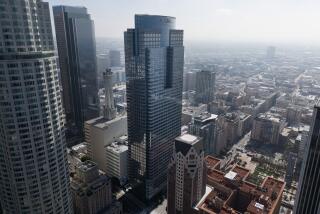TERROR IN OKLAHOMA CITY : City Divided on Whether to Rebuild Blast Site
- Share via
OKLAHOMA CITY — Its back side reduced to bent steel rods and crushed concrete, the Alfred P. Murrah Federal Building stands as a tomb in the center of Oklahoma City.
While the federal government makes plans to clear the rubble and rebuild, anxiety and even anger are beginning to surface as residents question whether that is the appropriate response to an event that will scar this state and its people forever.
“We aren’t like Los Angeles or New York,” said Oklahoma County Commissioner Shirley Darrell. “This is a close-knit community, and nothing this traumatic has ever happened to us. Rebuild the federal building and it’ll be a psychological wipeout for all of us.”
Talk shows are buzzing with people demanding that a memorial park be put on the site, with gardens of hardy marigolds to honor the spirits of those who died. “Most people don’t want a big building, a constant reminder of what happened staring them in the face every day,” said Cara Brandt, producer of a morning talk show on radio station KTOK. “They want something beautiful and special there to memorialize the dead.”
Throughout the city, residents are mounting fund-raising drives to pay for a memorial park, an eternal flame, or trees to represent every person killed at the site. Sydney Dobson, executive director of Oklahoma City Beautiful, a nonprofit organization formed to enhance the image of the city, is lobbying for a park at the site, which occupies an entire city block. “Over the weekend, the President was talking about rebuilding. I for one cannot imagine going back to work in that space where so many people died,” she said. “I don’t want to go back into that building, and might never want to go back into that building.”
Ultimately, the decision rests with the federal government, which owns the nine-story building and is waiting for rescue teams to complete their grim task of recovering the dead before deciding to demolish or rebuild.
Rep. Ernest Istook Jr. (R-Okla.) has been in contact with the General Services Administration, the federal government landlord that last year put the Murrah building’s replacement cost at $28 million. “We will certainly restore what has been lost, and the enduring symbol will be one of quick response and reconstruction,” he said. “I do not want to see an empty shell standing as an enduring monument to a terrorist attack.”
James Loftis, the Oklahoma City architect who designed the granite Murrah building in 1973, believes it is salvageable. The now-familiar sight of the building’s gaping back side presents only part of the picture.
An 180,000-square-foot underground parking garage, where about 600 cars are currently abandoned, survived the bomb virtually unscathed, Loftis said. The front of the building, where small glassed-in observation decks on each floor provide a 180-degree view of the city, appears to be in remarkably good shape, he added. Windows are blown out, but a large garden plaza out front is only cosmetically damaged.
“There are tricycles strewn about that were blown over from the children’s play yard, but that area is easily returnable to its former state,” he said.
“This building has been wounded, as have the people of this community and the state,” Loftis said. “But it is not dead. Economic considerations will have a lot to do with the decision. Attitudes will change as time passes.”
In the final analysis, whether the building is rebuilt or demolished is moot, said Dr. Jorg Pahl, an Oklahoma City psychiatrist specializing in the emotional effects of trauma. “The point is to somehow acknowledge that something terrible happened there, do something to commemorate the dead and the suffering. Whether it’s a park or a building is not important. The point is to actively deal with it in some manner and cleanse the soul.”
Although sentiment in this city of 440,000 seems to be strongly for creating a lasting monument to the victims, residents are at a loss for specific ideas because the scale of this disaster so exceeds anything the state has seen in its history.
When students learn about Oklahoma history, the bleakest chapters involve the Dust Bowl that saw thousands in the state flee famine and drought, and the death of Will Rogers in a 1935 plane crash in Alaska. No single disaster has ever approached the expected death toll from Wednesday’s blast--not even the largest tornadoes that batter this state every spring.
Some communities that have faced similar crises have responded by turning the original site into a memorial--such as in San Ysidro, where a small marble monument marks the spot where 21 people were murdered at a McDonald’s in 1984.
But in Killeen, Tex., where 23 people were killed during a noontime shooting rampage at a Luby’s cafeteria in 1991, residents successfully lobbied to reopen the restaurant at its original site.
Even if the federal building is reconstructed, it is unlikely that the new structure would fully protect federal workers from another strike. A bombproof building would require bunker-like construction that is both expensive and oppressive, Loftis said.
More to Read
Sign up for Essential California
The most important California stories and recommendations in your inbox every morning.
You may occasionally receive promotional content from the Los Angeles Times.










